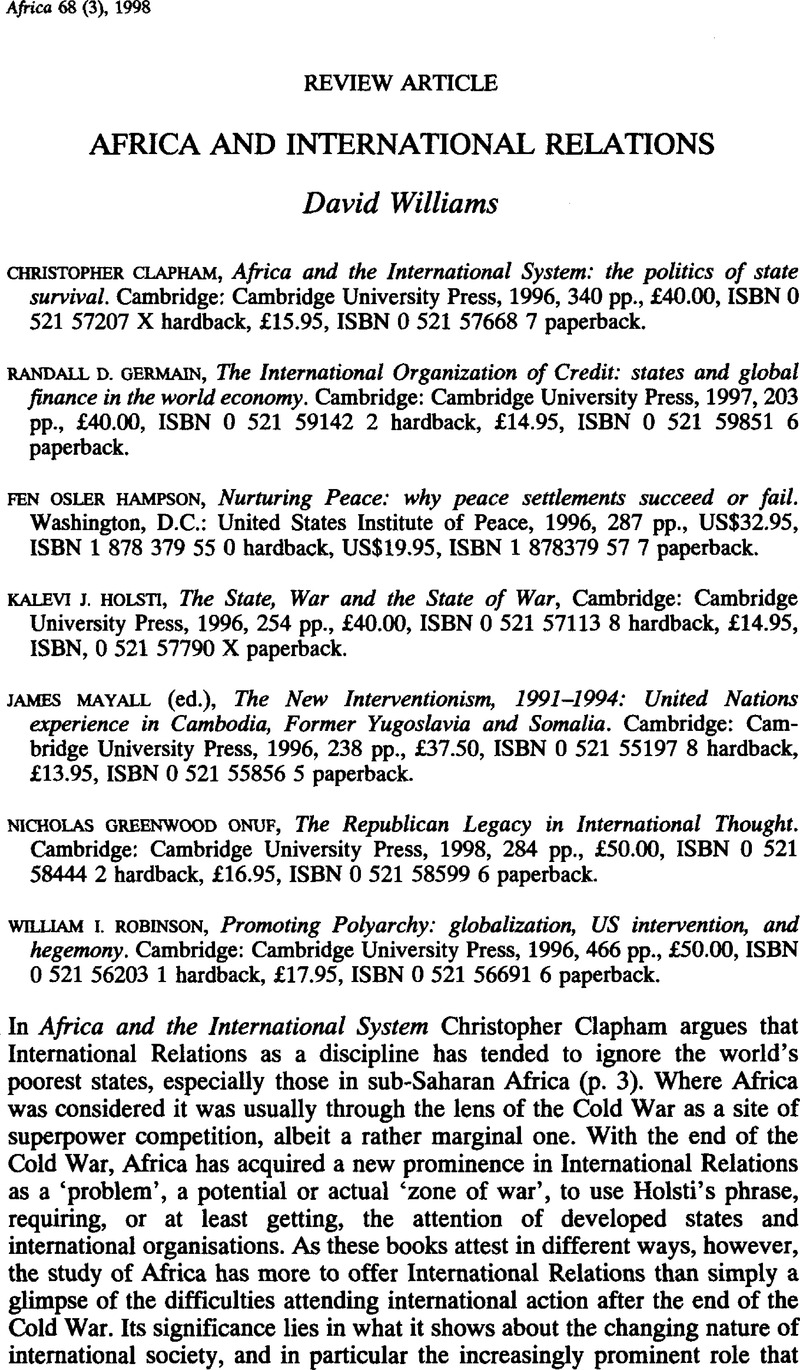No CrossRef data available.
Article contents
Africa and international relations
Published online by Cambridge University Press: 07 December 2011
Abstract
An abstract is not available for this content so a preview has been provided. Please use the Get access link above for information on how to access this content.

- Type
- Review Article
- Information
- Copyright
- Copyright © International African Institute 1998
References
Ayoob, M. 1995. The Third World Security Predicament: state-making regional conflict, and the international system. Boulder, Colo.: Lynne Reinner.CrossRefGoogle Scholar
Beitz, C. 1979. Political Theory and International Relations. Princeton, N.J.: Princeton University Press.Google Scholar
Bull, H. 1977. The Anarchical Society: a study of world order. London: Macmillan.CrossRefGoogle Scholar
Buzan, B. 1991. People, States and Fear: an agenda for international security studies in the post-Cold War era. London: Harvester Wheatsheaf.Google Scholar
Carr, E. H. 1964. The Twenty Years Crisis, 1919–1939: an introduction to the study of international relations, second edition. New York: Harper & Row.Google Scholar
Deng, F. 1995. ‘Reconciling sovereignty with responsibility: a basis for international humanitarian action’, in J., Harbeson and D., Rothchild (eds), Africa in World Politics: post-Cold War challenges. Boulder, Colo.: Westview Press.Google Scholar
Finnemore, M. 1996. ‘Constructing norms of humanitarian intervention’, in P., Katzenstein (ed.), The Culture of National Security: norms and identity in world politics. New York: Columbia University Press.Google Scholar
Kratochwil, F. 1989. Rules, Norms and Decision: on the conditions of practical and legal reasoning in international and domestic affairs. Cambridge: Cambridge University Press.CrossRefGoogle Scholar
Lister, S., and Stevens, M. 1992. ‘Aid Coordination and Management’. Internal World Bank paper, 22 April.Google Scholar
Moss, T. 1995. ‘US policy and democratisation in Africa: a post-Cold War assessment of the American national identity and the limits of liberal universalism’, Journal of Modern African Studies 33 (2), 1–16.CrossRefGoogle Scholar
Onuf, N. 1989. World of our Making: rules and rule in social theory and international relations. Columbia, S.C.: University of South Carolina Press.Google Scholar
Roberts, A., and Kingsbury, B. (eds). 1993. United Nations, Divided World: the UN's role in international relations. Oxford: Clarendon Press.Google Scholar
Sheppard, S. 1998. ‘Foot soldiers of the New World Order: the rise of the corporate military’, New Left Review 228 (March-April), 128–38.Google Scholar
Waltz, K. 1959. Man, the State and War: a theoretical analysis. New York: Columbia University Press.Google Scholar
Wendt, A. 1992. ‘Anarchy is what states make of it: the social construction of power polities’, International Organisation 46 (2), 391–425.CrossRefGoogle Scholar
Williams, D. 1996. ‘Governance and the discipline of development’, European Journal of Development Research 8 (2), 157–77.CrossRefGoogle Scholar
Williams, D., and Young, T. 1994. ‘Governance, the World Bank and liberal theory’, Political Studies 42 (1), 84–100.CrossRefGoogle Scholar
World Bank. 1989. Sub-Saharan Africa: from crisis to sustainable growth. Washington, D.C.: World Bank.Google Scholar
World Bank. 1991. World Development Report 1991: the challenge of development. Washington, D.C.: World Bank.Google Scholar
World Bank. 1997. World Development Report 1997: the state in a changing world. Washington, D.C.: World Bank.Google Scholar
Zartman, W. 1985. Ripe for Resolution: conflict and intervention in Africa. Oxford: Oxford University Press.Google Scholar


